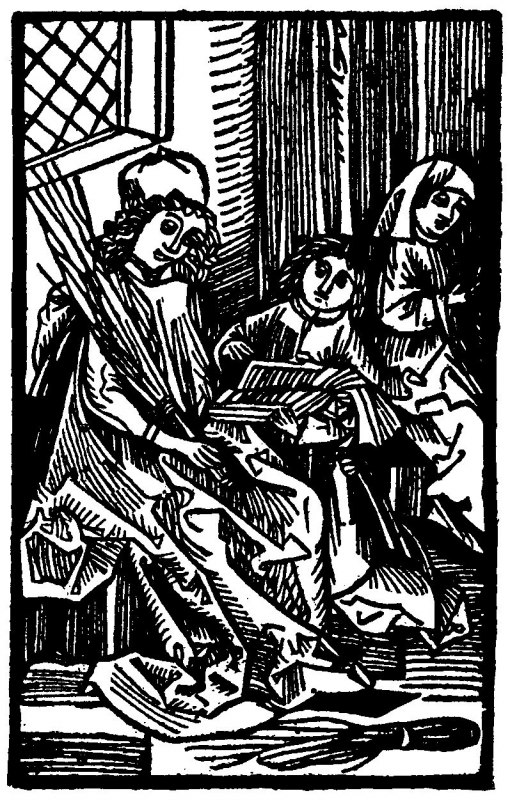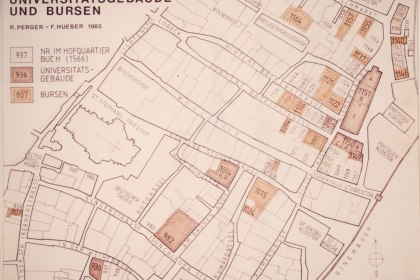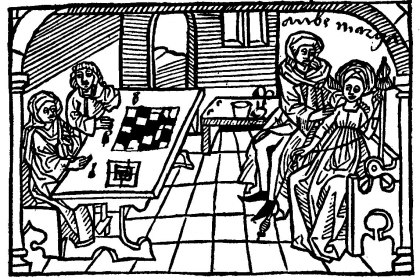Bursae and coderies
How did a student live in the Middle Ages? Was finding appropriate housing his private matter or did the university have influence on student accommodations? Because the university understood itself as a “community of teachers and students”, its regulations not only encompassed the areas of teaching and learning, but also its members’ lifestyle. This also affected the oversight of student housing. By today’s standards the supervision was rather strict – not surprising, since the average age of the majority of students was equivalent to that of a high school student today.
The goal set by the university was to have all students live under the control of a magister, which never actually was implemented. Still, a large part of the student body lived in student housing controlled by the university, the so-called bursae. Poor students had the option of living in student alms houses called coderies.
Since most students at the University of Vienna came from outside of the city, they were faced with the problem of finding accommodations. We can deduce from the medieval matriculation numbers that the students represented about 8 - 10 % of the city’s total population. Thus, providing student quarters and in particular supervising them were important issues for the university administration.
The university tried to keep the student housing under their control as much as possible, particularly due to the students’ young age. In its statutes from 1389, the Faculty of Arts decreed that all students should live and study under the supervision of a magister. This decree was apparently never completely fulfilled, since in 1413 rules were set for those students who lived “privately” – in shared apartments or as servants of citizens. They were contrasted with the bursa residents.
Bursae
The first bursae were privately led institutions: A magister – most often from the Faculty of Arts – offered quarters, meals and lessons for a weekly fee (the bursa, from which the name of this type of student housing was derived). He was responsible to the university for supervising the students, but he also was dependent on them as paying customers, which led to the university complaining about lax discipline in the bursae. These student accommodations were subject to the laws of supply and demand, meaning that many bursae only existed for a short while in times of high student numbers.
Next to these, another type of bursae developed: Those financed through private foundations, which thus were less susceptible to economic fluctuations. The heads of these bursae (called conventors in the Middle Ages, and later superintendents) also were more independent from the students because these no longer were the direct source of money, but themselves were dependent on the payment of the scholarships. Due to this, the heads of the “foundation bursae” could more easily enforce disciplinary rules as opposed to those of the “entrepreneurial bursae”.
Strictly regulated daily life in a bursa
Life in a bursa was governed by a strict set of rules, just like in the university itself. The statutes of early “entrepreneurial bursae” are not recorded, even though they most certainly existed. The most famous bursa statutes are those of the Rosenburse, written by Thomas Ebendorfer von Haselbach in 1432. They served as an example for other bursae. New members of the bursa had to take an oath to uphold these statutes. The rules governed subjects such as collective and individual religious duties or communal meals. These in particular made up an important part of the daily life: They were supposed to foster social cohesion among the residents of the bursa. They also gave an opportunity to have intellectual discussions in Latin – exclusive use of this language was also regulated in the statutes. The number of lectures one was supposed to visit depended on the rules of the bursa. Apart from this, practice dispositions were also offered in the student houses. Visiting “disreputable” places, such as taverns or brothels, was of course forbidden, as was contact with women, which is why the presence of women in the bursa was completely prohibited and punished severely.
Student alms houses – coderies
Bursae – even foundation bursae – were not primarily meant for poor students, even though it said in the entry regulations of some foundation bursae that they were dedicated to “the poor”. They were mainly meant for the benefactor’s family members or for students from their home cities or regions. Since Vienna was one of the universities most frequented by pauperes, dedicated student accommodations were set up for them. In these so-called coderies, officially recognized poor students could live for a lower rent than in the bursae. The originally Middle High German word “kote” meant a humble hut (the word “Kotter” developed from this) and was used by the students in the Latinized version “codria”. Similar to the bursae, the coderies were supervised by a conventor who usually was appointed by the Faculty of Arts.
In principle, life in the coderies was also regulated by rules, but the students living here usually did not receive lessons. They earned their keep by begging or singing in the city. Apparently, the coderies had less strict rules than the bursae, because the faculty of arts (who actually were responsible for the supervision) repeatedly complained that many well-off students lived in the coderies, because they preferred these alms houses to the bursae “due to the greater freedom”.
Attempts to reform the bursa system under Ferdinand I
In the course of the university reforms under Ferdinand I, a large part of the bursae and coderies was also reviewed. Investigations showed that a majority of scholarship positions were not being used or that non-university members lived in the bursae. The study progress and the discipline among the bursae and coderie residents were also unsatisfactory. Because of this, the university was to do regular checks (visitations) of the student accommodations and to pay attention to the correct allocation of places in the foundation bursae, since influential people often provided for clients in this way.
Despite these attempts at revitalizing the system a large number of the medieval bursae disappeared in the course of the 16th century. Among the reasons for this were changes in the university’s teaching ideals due to Renaissance humanism, competition by the Jesuits and also the changing catchment area of the University of Vienna, which focused more and more on Vienna and its surroundings. Students from the city usually did not need accommodations, since they still lived with their families.
Especially the large bursae funded through endowments survived – for example the Rosenburse, the Lammburse or the Lilienburse. However, after numerous university buildings were given to the Jesuits in 1623, they were mostly transformed into financial scholarships, because the houses were demolished to make space for the building of the Jesuit church and the college building at today’s Dr. Ignaz Seipel-Platz. The coderie Goldberg as the largest student alms house in Vienna also survived until the 20th century. After a few years without a residence when the coderie building was lost in 1623 it received a building in Johannesgasse, which was used until the 18th century. Only after this was it also transformed into a scholarship.
-

Die mittelalterlichen Universitätsgebäude und Bursen in Wien
Originalplan Nr. AUA 8549 von Richard Perger Friedmund Hueber im Archiv der Universität Wien. Der Plan zeigt das Stadtviertel beim Stubentor mit der...
Zuletzt aktualisiert am 03/05/24
-
Thomas Ebendorfer von Haselbach
10.8.1388–12.1.1464
Studentenhaus in der Kärntnerstraße
Rosenburse
Kodrei „Domus Poloni“, später Kodrei Goldberg
Paulusburse, „Bursa Pauli“
Heidenburse (Burse Heidenheim), ab 1520 auch Sitz der Paulusburse
Lammburse („Bursa Agni“)
Bruckburse („Bursa Pontis“)
Lilienburse
Schlesierburse
Kodrei Pankota
Kelhaimerburse, „Domus Kelhaim“
Rauchburse (Neue Burse)
Burse zum Einhorn
Löwenburse („Zum goldenen Löwen“)
Schärdinger- oder Würfelburse
Schwaiger- oder Schlierstadtburse (beim Kelhaimerhaus)
Harrerburse alias St. Hieronymusburse
Kodrei im Haus des Laurenz Haiden
Burse im Haus des Tischlers Rauch
Haus Goldberg
-
“Fossen” and “Partekenfresser”
15th Cent.–16th Cent.








